Nepal, a land famed for the soaring peaks of the Himalayas and a tapestry of cultural traditions, is dotted with villages that are as diverse as they are picturesque. These spots provide a window into the authentic rural essence of Nepal, highlighting the serene beauty of its nature, the variety of its cultural fabric, and the depth of its historical roots. Key among these are ten villages that offer distinct experiences, from Namche Bazar, the bustling gateway to Everest, to the ancient allure of Kagbeni in the mystical Upper Mustang. Experiences in Ghandruk and Ghale Gaun dive deep into Gurung culture, offering stays in local homes and cultural exchanges, while the vistas from Chisapani and Dhampus villages stretch the Himalayan horizon into the infinite. In Manang and Khangsar Village, travelers find themselves whisked into a realm of Tibetan heritage and untouched wilderness. Chhusang Village reveals its medieval character and intriguing cave abodes, whereas Bandipur stands for villages as a timeless showcase of Newari architectural grandeur. These destinations offer more than just visits; they are invitations to immerse oneself in the Nepalese way of life, culture, and unparalleled natural splendor, making them essential stops on any journey to grasp the soul of Nepal.
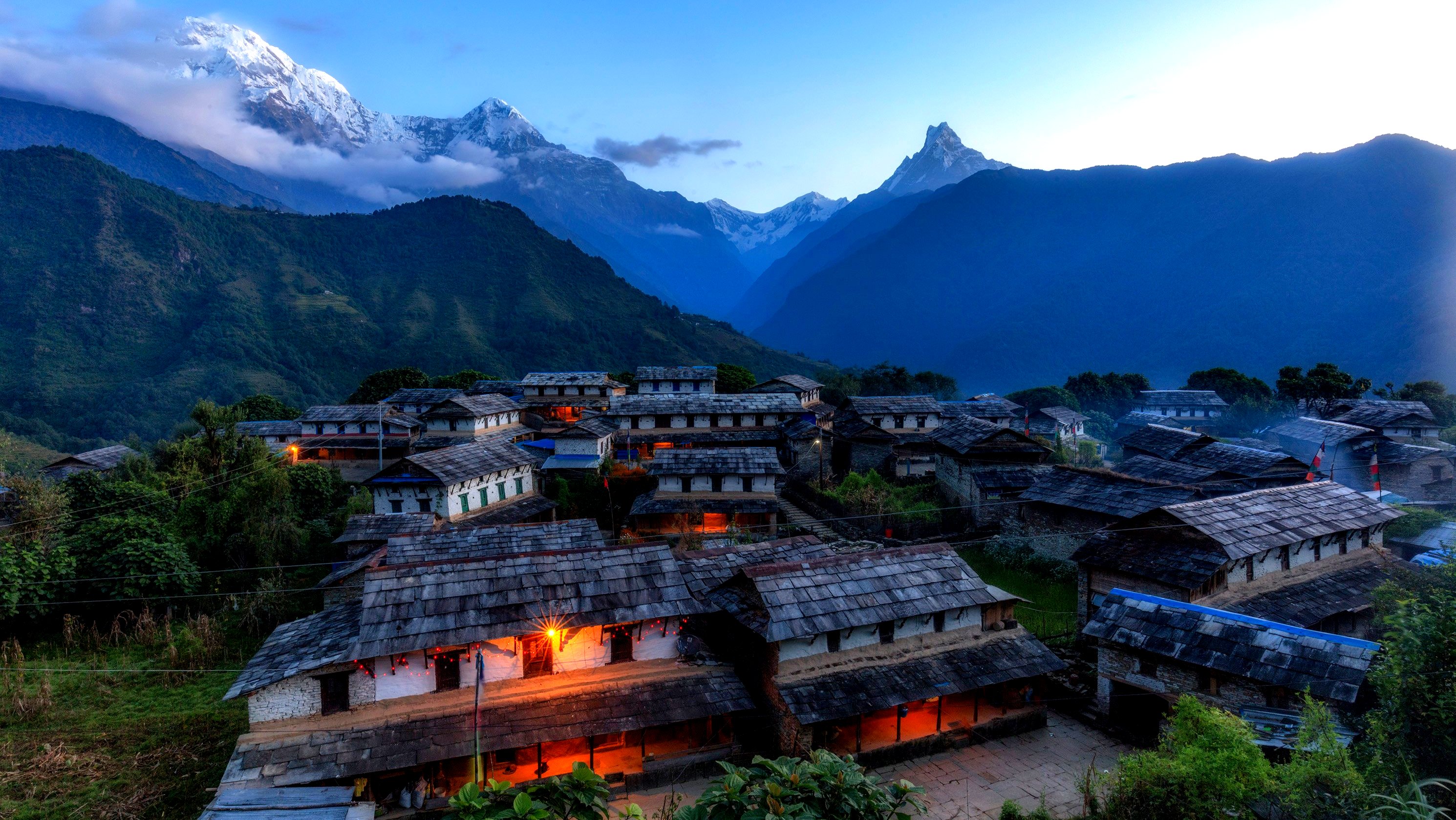
Luxury Holidays Nepal Pvt. Ltd. stands out as the go-to company for experiencing Nepal's Top 10 Enchanting Village Tours. Known for offering unique and immersive tours, they bring you closer to the heart of Nepal's stunning landscapes and rich cultural tapestry. With a focus on luxury and personalized experiences, they ensure every journey is memorable, guiding you through the serenity of Nepal's picturesque villages. From the historic alleys of Bandipur to the breathtaking views from Dhampus, their curated tours are designed to showcase the very best of Nepal's rural beauty. Discover unparalleled hospitality and the essence of Nepalese culture with Luxury Holidays Nepal, making your trip not just a vacation, but a journey into the soul of this incredible country.
Namche Bazar
Nestled high in the Himalayas of Nepal, Namche Bazar stands as a vibrant heart of the Khumbu region, acting as the central hub for trekkers and adventurers headed towards Everest Base Camp. This bustling market town is not just a stopover; it's a cultural and commercial amalgam that offers a glimpse into the life high above sea level. Known for its remarkable altitude and unique Sherpa culture, Namche serves as an essential acclimatization point for those aiming to scale higher altitudes, making it an indispensable part of the Everest experience.
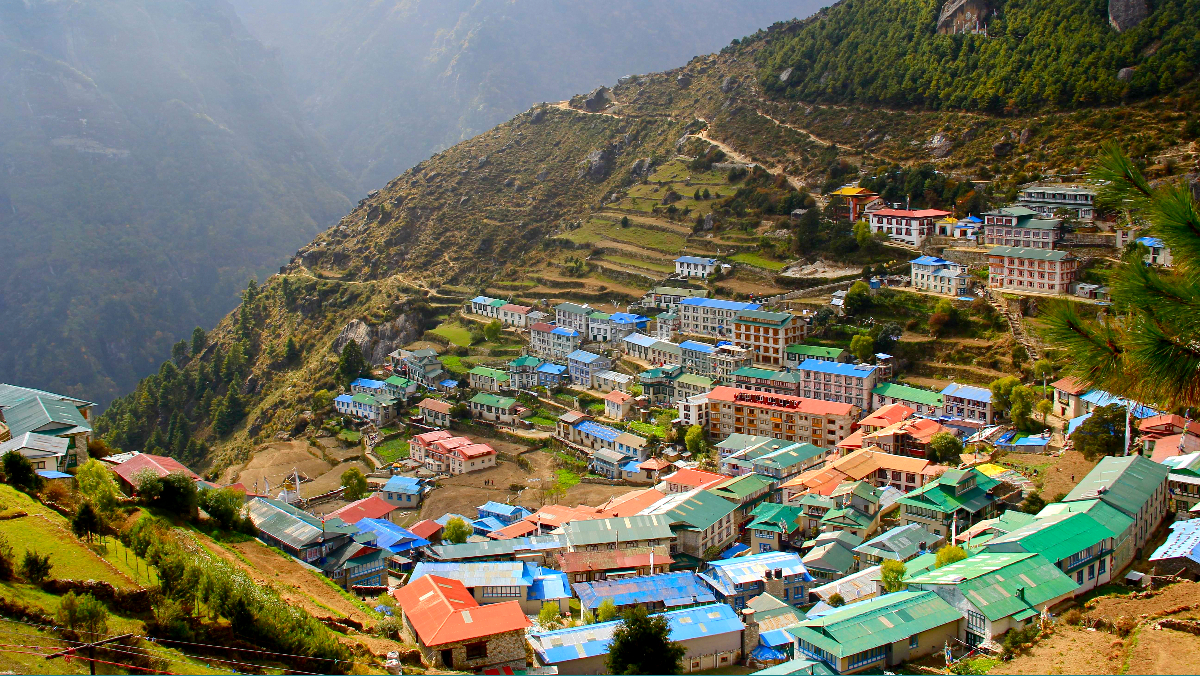
Key Features of Namche Bazar:
-
Gateway to Everest: Namche Bazar is strategically located to serve as the gateway to the Everest region, providing a critical acclimatization stop for trekkers and climbers on their journey to the base camp and beyond.
-
Cultural Hub: The town is a vibrant center of Sherpa culture, offering visitors the chance to immerse themselves in local traditions, cuisine, and daily life. The Sherpa Museum in Namche is a must-visit for those interested in the history and culture of the Sherpa people.
-
Saturday Market: Namche's weekly market is a focal point for trade and social gatherings. Here, locals and traders from neighboring regions come together to sell everything from fresh produce to mountaineering gear, providing a colorful insight into the economic life of the Himalayas.
-
Panoramic Views: Positioned at an altitude of 3,440 meters, Namche offers stunning panoramic views of the Himalayan peaks, including Mount Everest, Lhotse, and Ama Dablam. The view from the National Park Headquarters just above the town is particularly breathtaking.
-
Hiking and Exploration: Various hikes and walks start from Namche, including those to the Everest View Hotel, Khumjung village, and the Thame Monastery. These treks offer magnificent views and a deeper understanding of the region's geography and culture.
-
Accommodations and Amenities: Despite its remote location, Namche boasts a range of accommodations, from basic lodges to more comfortable hotels, catering to the needs of every traveler. Cafes, bakeries, and even internet cafes ensure visitors stay connected and energized for their trekking adventures.
Namche Bazar is much more than just a pit stop for those venturing higher into the Everest region; it's a vibrant community rich in culture, history, and natural beauty. Whether you're acclimatizing for a trek, exploring local Sherpa culture, or simply soaking in the views of the world's highest peaks, Namche Bazar offers a unique blend of experiences that encapsulate the spirit of the Himalayas.
Kagbeni
Kagbeni, a quaint village in the Mustang district of Nepal, is a place where ancient traditions meet the rugged beauty of the Himalayas. Lying at the edge of the Kali Gandaki gorge, the deepest in the world, this medieval village is often described as the gateway to Upper Mustang, offering a peek into a landscape and culture that has remained largely untouched by time.
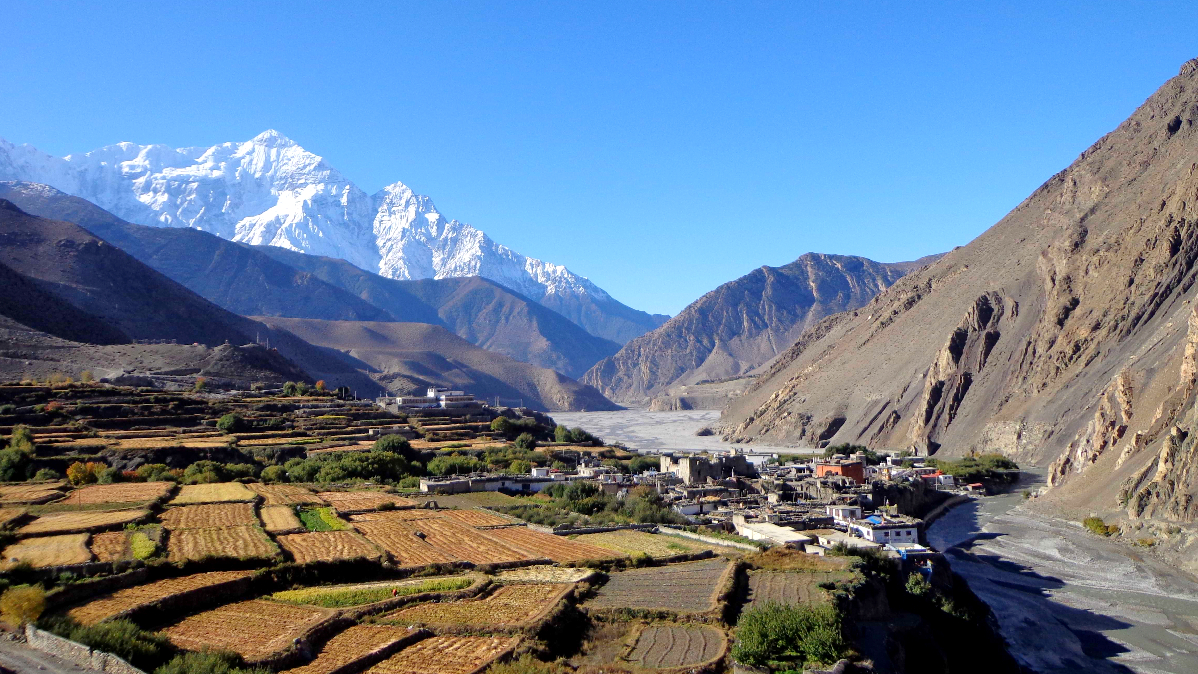
Key Features of Kagbeni:
-
Ancient Architecture: The narrow alleyways and traditional mud-brick houses of Kagbeni are a testament to its rich history. The village is dominated by its iconic red monastery, which is several centuries old and holds significant religious importance for the local community.
-
Cultural Crossroads: Kagbeni serves as a cultural crossroads, where traders from the north (Tibet) and the south (lower parts of Nepal) have exchanged goods for centuries. This has enriched Kagbeni with a unique blend of Buddhist and Hindu traditions.
-
Gateway to Upper Mustang: For travelers seeking to explore the mystical lands of Upper Mustang, Kagbeni marks the entry point. The region beyond Kagbeni is known for its stark landscapes, ancient monasteries, and cave dwellings, offering a stark contrast to the lushness of the Annapurna region.
-
Stunning Natural Beauty: The village provides breathtaking views of the surrounding Himalayan peaks and the Kali Gandaki river. The unique wind-eroded landscapes, often referred to as the desert of the Himalayas, present a dramatic backdrop for exploration.
-
Trekking Hub: Besides being an entry point to Upper Mustang, Kagbeni is also a popular stop for trekkers on the Annapurna Circuit. The trails around the village offer diverse trekking experiences, from lush valleys to arid high-altitude deserts.
-
Spiritual Site: The Kag Chode Thupten Samphel Ling Monastery, located in the heart of the village, is a spiritual center for locals and visitors alike. It houses ancient scriptures and artifacts, offering insights into Buddhist philosophy and art.
Kagbeni is not just a village but a doorway to a different time and place. Its unique position as both a literal and figurative gateway between different worlds – the lush Annapurna region and the arid landscapes of Upper Mustang – makes it an essential visit for those looking to experience the diversity of Nepal's natural and cultural landscapes. Whether you're a trekker, a culture enthusiast, or simply in search of tranquility, Kagbeni promises a memorable journey into the heart of the Himalayas.
Ghandruk
Ghandruk, situated within the Annapurna Conservation Area, is a picturesque village that epitomizes the serene beauty and rich cultural tapestry of Nepal. Known for its stunning views of the Annapurna range, including the majestic Machapuchare (Fishtail Mountain), Annapurna South, and Hiunchuli, Ghandruk is a favored destination for trekkers and cultural enthusiasts alike.
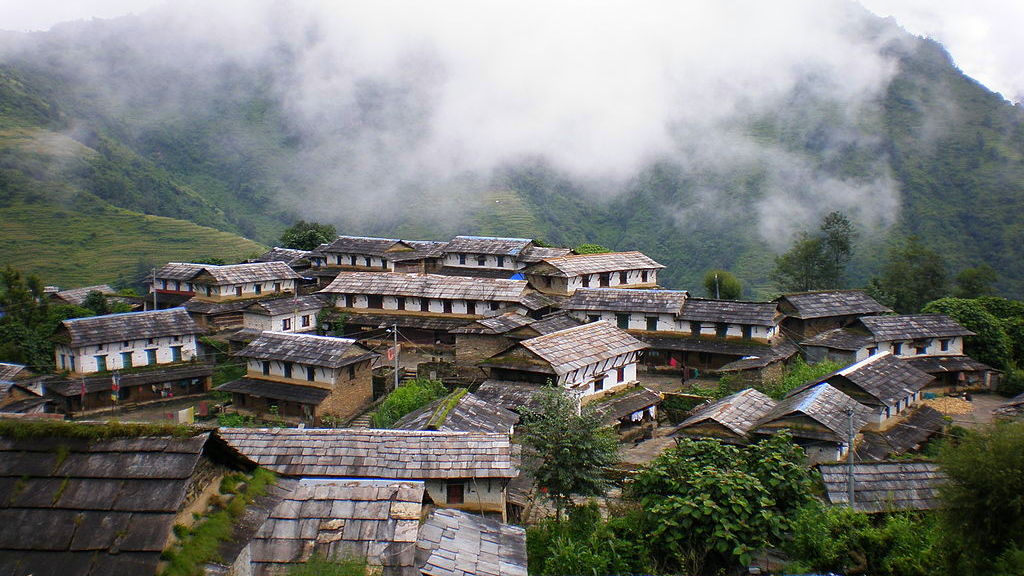
Key Features of Ghandruk:
-
Spectacular Mountain Views: Ghandruk offers unparalleled views of the Annapurna South, Hiunchuli, Gangapurna, and the iconic Machapuchare. The village's vantage point provides a panoramic spectacle that is both inspiring and breathtaking.
-
Rich Gurung Culture: The village is predominantly inhabited by the Gurung people, an ethnic group known for their rich traditions and contributions to the Gurkha regiments. Visitors can immerse themselves in the local culture through traditional dances, music, attire, and festivals.
-
Trekking Hub: Ghandruk serves as a key stop on several popular trekking routes, including the Annapurna Base Camp trek and the Poon Hill trek. Its trails offer a blend of natural beauty and cultural exploration, making it an ideal starting point or rest stop for trekkers.
-
Sustainable Tourism: The community in Ghandruk has embraced sustainable tourism practices, showcasing eco-friendly initiatives such as local homestays. This not only provides an authentic experience for visitors but also supports the local economy and conservation efforts.
-
Gurung Museum: For those interested in learning more about the history and lifestyle of the Gurung people, the Gurung Museum in Ghandruk is a must-visit. It houses a collection of traditional tools, clothing, and photographs, offering insights into the local heritage.
-
Flora and Fauna: Located in the Annapurna Conservation Area, the village is a haven for nature enthusiasts, offering a chance to encounter diverse wildlife and explore untouched forests and landscapes.
-
Local Handicrafts and Gastronomy: The village also serves as a window into local crafts and the culinary arts. Exploring the handmade textiles, and traditional jewelry, and sampling local dishes like dhido and homemade spirits provides a taste of the Gurung culinary tradition.
Ghandruk is more than just a place to visit; it's a vibrant experience that marries the grandeur of the Himalayas with the rich cultural tapestry of the Gurung community. For those venturing into the Annapurna region, looking for cultural depth, or eager to behold nature's marvels, Ghandruk promises a journey filled with discovery and awe.
Ghale Gaun
Ghale Gaun, beautifully perched in the Lamjung District of Nepal, is a shining example of community-based tourism done right. This village, set against the breathtaking backdrop of the Annapurna range, offers a unique glimpse into the lives of the Ghale and Gurung communities, renowned for their rich cultural heritage and warm hospitality.
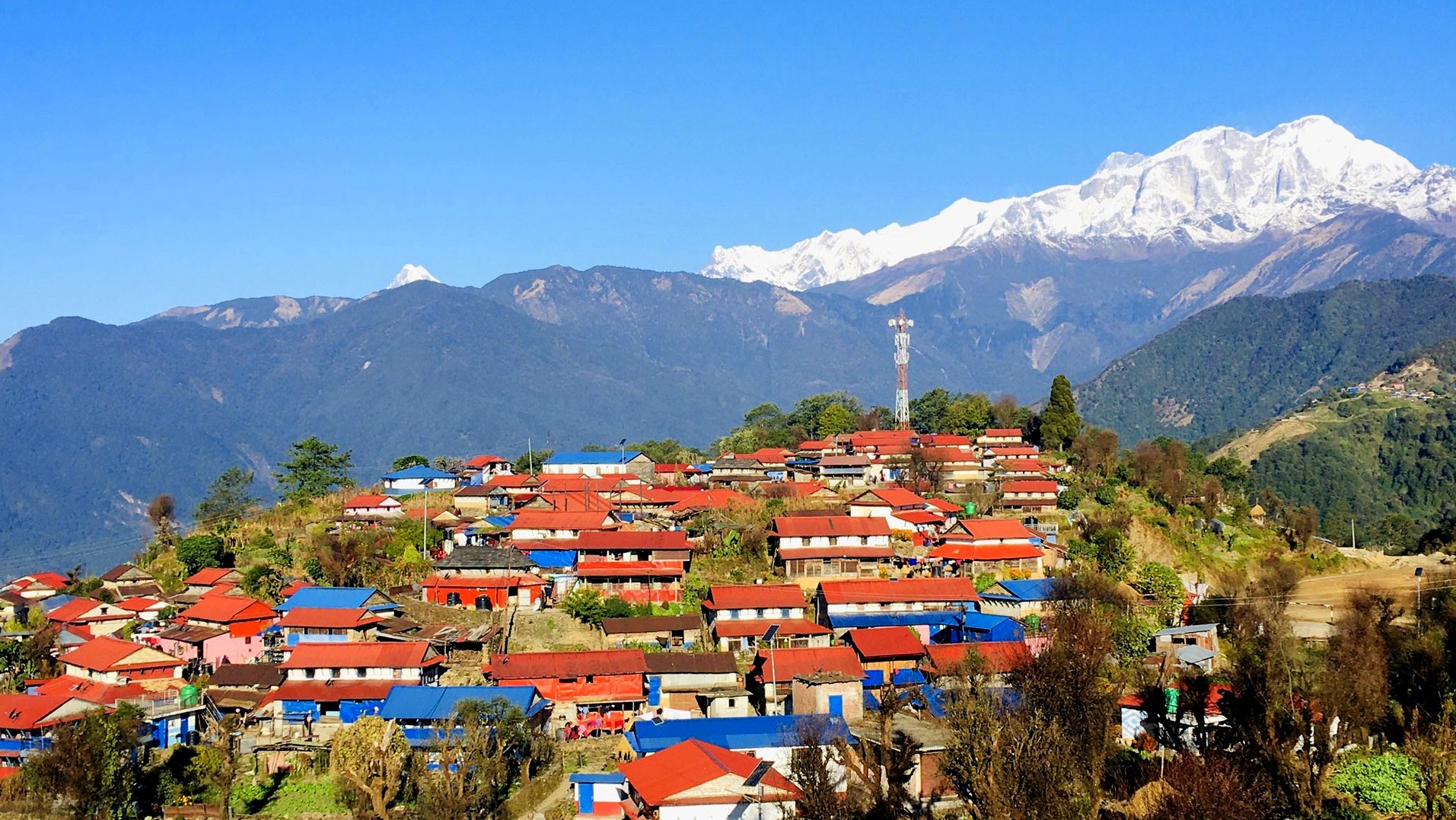
Key Features of Ghale Gaun:
-
Cultural Immersion: Ghale Gaun is celebrated for its efforts to preserve and showcase the traditional lifestyles of the Gurung and Ghale communities. Visitors have the opportunity to stay with local families in their homes, experiencing firsthand the culture, cuisine, and daily life of these indigenous people.
-
Panoramic Mountain Views: The village boasts spectacular views of the Annapurna circuit, including peaks like Annapurna II, Lamjung Himal, and Manaslu. The natural beauty surrounding Ghale Gaun is simply unmatched and serves as a perfect backdrop for trekkers and nature lovers.
-
Eco-friendly and Sustainable Practices: The community's commitment to sustainability is evident in its eco-friendly tourism practices. This includes everything from organic farming to the use of renewable energy sources, making it a model village for conservation efforts.
-
Community Projects and Homestays: The homestay program in Ghale Gaun is a cornerstone of its tourism model, allowing visitors to engage directly with community projects, from educational initiatives to environmental conservation. This engagement fosters a deeper connection between visitors and the local community.
-
Cultural Programs: The village organizes cultural programs for visitors, showcasing traditional dances, music, and festivals that reflect the rich heritage of the Gurung and Ghale people. These programs offer a deeper understanding of the local culture and traditions.
Ghale Gaun village exploration offers an unforgettable experience that connects visitors with the natural beauty and cultural richness of Nepal. Through its sustainable tourism model, the village not only provides a unique travel experience but also plays a crucial role in preserving the cultural heritage and natural environment of the region. Whether you're interested in cultural immersion, breathtaking natural scenery, or sustainable travel, Ghale Gaun offers an authentic and enriching journey into the heart of Nepal.
Chisapani
Chisapani is a small yet remarkably scenic village located on the fringes of the Kathmandu Valley, offering an exquisite gateway to the natural beauty of Nepal. It serves as a popular starting or finishing point for trekkers embarking on the Shivapuri Nagarjun National Park trek, providing a peaceful retreat from the bustling life of the city.

Key Features of Chisapani:
-
Panoramic Mountain Views: Chisapani presents stunning vistas of the Himalayan range, including views of Langtang Lirung, Ganesh Himal, and on clear days, even Mount Everest. Its vantage point allows for magnificent sunrise and sunset views, painting the sky in vibrant hues.
-
Rich Biodiversity: Being located within Shivapuri Nagarjun National Park, Chisapani is surrounded by rich biodiversity. The area is a habitat for various species of birds and wildlife, making it a great spot for bird watchers and nature enthusiasts.
-
Trekking Hub: The village acts as a pivotal point for several trekking routes, offering access to lush forests, serene waterfalls, and rustic villages. The trek to or from Sundarijal through Chisapani is one of the most popular hikes, appreciated for its natural beauty and relatively easy trails.
-
Gateway to Langtang: For trekkers looking to explore deeper into the Langtang region, Chisapani serves as an introductory experience to the landscapes and cultural experiences that lie ahead on more extended treks.
-
Local Life and Hospitality: Visitors have the opportunity to experience the warm hospitality of the local people, predominantly of the Tamang community. Staying in guesthouses and teahouses allows for a genuine insight into the lifestyle and culture of Nepal's hill communities.
Chisapani is not only a trekker's delight but also a tranquil escape for anyone wishing to experience the beauty of Nepal's natural landscapes and the warmth of its people. Whether you're a solo traveler, a part of a trekking group, or simply looking for a quiet getaway close to Kathmandu, Chisapani offers a unique blend of cultural and natural exploration.
Manang
Manang is a captivating village in the heart of the Annapurna region of Nepal, offering a blend of breathtaking natural beauty and rich cultural experiences. Situated at an altitude of over 3,500 meters, it serves as a pivotal stop on the famous Annapurna Circuit trek, drawing adventurers and culture enthusiasts from around the globe.
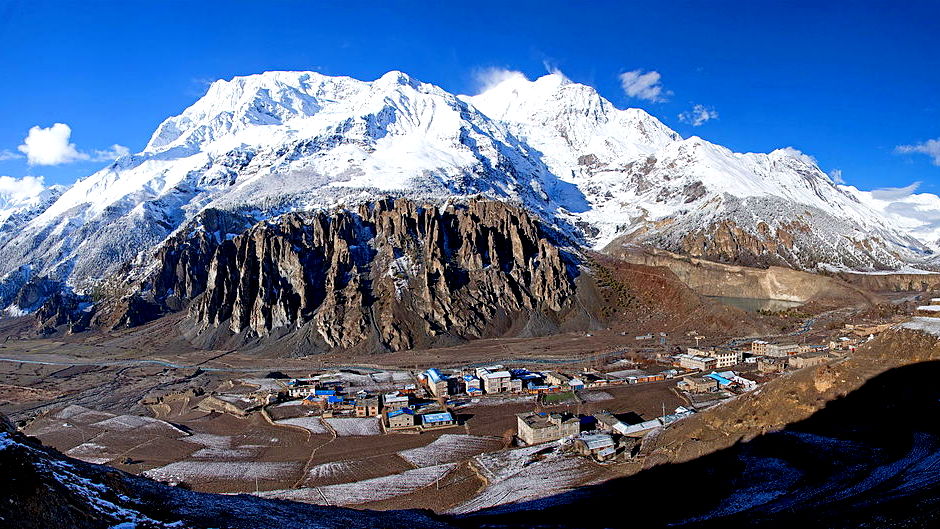
Key Features of Manang:
-
Stunning Natural Scenery: Manang is surrounded by the majestic Himalayas, with views of Annapurna II, III, and IV, Gangapurna, and Tilicho Peak. The landscape offers a dramatic mix of high-altitude lakes, barren cliffs, and lush valleys, providing a mesmerizing backdrop for trekkers.
-
Rich Cultural Tapestry: The village is predominantly inhabited by the Nyingma and Gurung communities, whose traditions and lifestyles have been preserved over centuries. Visitors can explore ancient monasteries, traditional stone houses, and unique cultural practices that reflect the spiritual heritage of the region.
-
Gateway to High-altitude Treks: Manang acts as an acclimatization point for trekkers heading towards the Thorong La Pass, one of the highest trekking passes in the world. It's also the starting point for excursions to the pristine Tilicho Lake, known as the highest lake for its size in the world.
-
Biodiversity and Wildlife: The region is part of the Annapurna Conservation Area, one of Nepal's largest protected areas. It is home to diverse flora and fauna, including rare species such as the snow leopard and blue sheep, offering unique opportunities for wildlife observation.
-
Adventure Activities: Beyond trekking, Manang offers a range of adventure activities, including mountain biking, rock climbing, and paragliding. The clear blue skies and rugged terrain make for an adrenaline-filled experience amidst the tranquility of the Himalayas.
Manang is a jewel in the Annapurna region, offering an unparalleled mix of natural beauty, cultural richness, and adventure. Whether you're trekking through the Himalayas, exploring ancient cultures, or simply soaking in the serene landscapes, Manang is a destination that provides unforgettable experiences.
Khangsar Village
Khangsar Village is a hidden gem of the Annapurna region, that offers an authentic glimpse into traditional Himalayan life. This secluded village, located near Manang and on the way to Tilicho Lake, is less frequented by tourists, making it a perfect spot for those seeking tranquility and a deep cultural immersion.
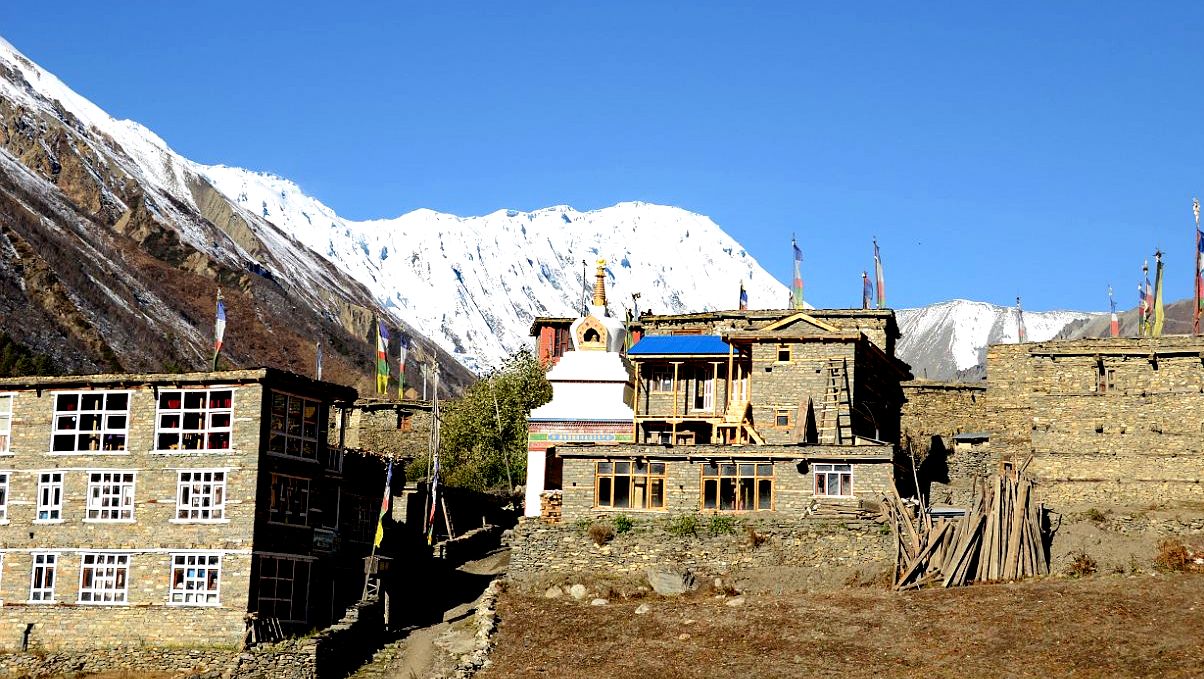
Key Features of Khangsar Village:
-
Traditional Tibetan Lifestyle: Khangsar Village is one of the last places in Nepal where you can witness a traditional Tibetan lifestyle, untouched by modernization. The villagers maintain a strong adherence to their ancient customs and practices, providing a unique cultural experience.
-
Architectural Heritage: The village is characterized by its stone houses with flat roofs, a common feature in Tibetan architecture. These structures blend seamlessly with the rugged landscape, symbolizing the harmony between man and nature in the Himalayas.
-
Gateway to Tilicho Lake: Khangsar serves as a base for trekkers heading to Tilicho Lake, one of the highest lakes in the world. The journey from Khangsar to the lake offers breathtaking views and a challenging trek through some of the region's most dramatic scenery.
-
Rich Biodiversity: The area around Khangsar is known for its rich biodiversity, part of the larger Annapurna Conservation Area. Trekkers can spot a variety of flora and fauna unique to this high-altitude ecosystem, including medicinal herbs and rare animal species.
-
Spiritual Sites: The village and its surroundings are dotted with ancient monasteries and religious sites that reflect the deep spiritual beliefs of the local community. Visiting these sites offers insight into the village's Buddhist traditions and practices.
Khangsar Village is a testament to the enduring spirit of the Himalayan people, offering a rare opportunity to explore untouched landscapes and centuries-old cultures. For those willing to venture off the beaten path, Khangsar provides a profound and enriching experience that captures the essence of Nepal's remote highlands.
Chhusang Village
Chhusang Village, located in the Mustang region of Nepal, offers a fascinating blend of rugged landscapes and ancient history, providing a rare glimpse into the lives of those who live in one of the country's most isolated regions. This village is often a key stop for trekkers on their way to explore the hidden kingdom of Mustang or on the famous Annapurna Circuit.
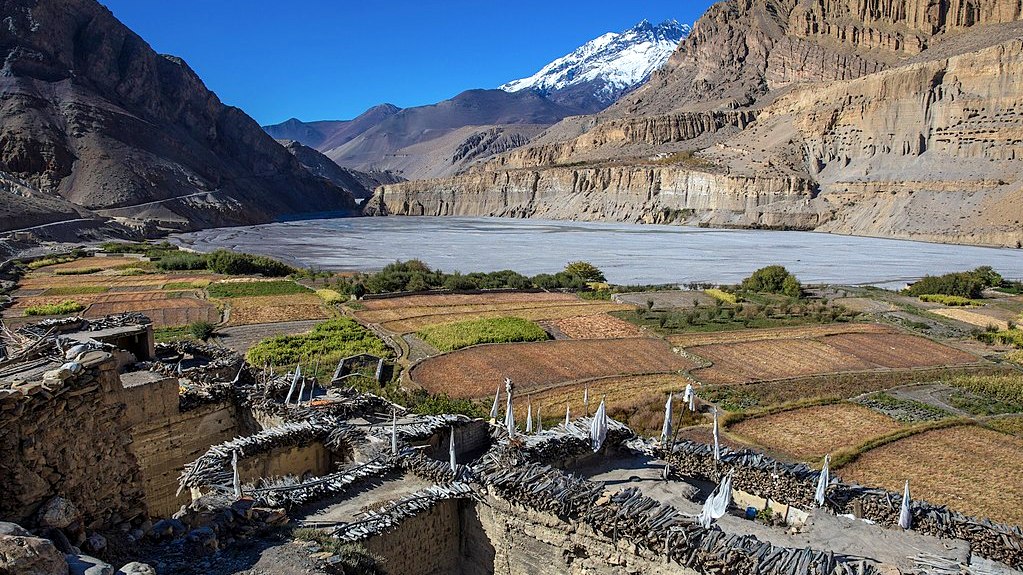
Key Features of Chhusang Village:
-
Rich Historical Significance: Chhusang is known for its archaeological importance, with ancient cave dwellings carved into the cliff sides and centuries-old stupas that dot the landscape. These historical sites provide a glimpse into the early Buddhist settlers' way of life.
-
Striking Natural Formations: The village is surrounded by unique red sandstone cliffs that hold significant geological interest. These formations are not only a marvel to look at but also home to many of the aforementioned cave dwellings, some of which are still in use today.
-
Gateway to Upper Mustang: For those with permits to enter the restricted areas of Upper Mustang, Chhusang serves as an entry point to this mysterious and isolated region. Its location offers a taste of the stark, lunar landscapes and rich Tibetan culture that characterizes Upper Mustang.
-
Rural Nepali Life: Despite its growing popularity among trekkers, Chhusang retains a sense of untouched beauty and traditional lifestyle. The village's agriculture and livestock are central to its economy, offering visitors a chance to see traditional Nepali village life in action.
-
Access to Sacred Sites: Near Chhusang, visitors can explore sacred sites like the Muktinath Temple, an important pilgrimage destination for both Hindus and Buddhists. The trek to Muktinath from Chhusang is a journey through diverse landscapes and spiritual history.
Chhusang Village serves as a captivating introduction to the Mustang region's unique blend of culture, history, and natural beauty. It offers a quieter, more introspective trekking experience compared to Nepal's more crowded trails, making it an ideal destination for those looking to immerse themselves in the serene and spiritual aspects of the Himalayas.
Bandipur
Bandipur, perched atop a hill, seamlessly marries the charm of ancient Nepal with the tranquility of the Himalayas. This preserved village, midway between Kathmandu and Pokhara, is a testament to the rich Newari culture that flourishes within its boundaries. Bandipur captivates visitors with its well-preserved architecture, cobbled streets, and panoramic views of the Himalayan range.

Key Features of Bandipur:
-
Cultural Heritage: Bandipur is renowned for its beautifully maintained Newari architecture, including traditional houses with carved wooden windows and balconies. The town's history as a trading stop has left a legacy of rich culture and architecture that continues to draw visitors.
-
Panoramic Mountain Views: From its vantage point, Bandipur offers stunning views of the Himalayas, including Dhaulagiri, Annapurna, Manaslu, and Langtang ranges. The Tundikhel field in the heart of Bandipur is one of the best spots to soak in these breathtaking vistas.
-
Pedestrian-Friendly Streets: The absence of vehicular traffic in the main part of town makes Bandipur an ideal place for leisurely strolls. Its cobbled streets and alleyways invite exploration, leading visitors to temples, shrines, and traditional Newari shops.
-
Adventure and Activities: Besides cultural exploration, Bandipur offers opportunities for adventure activities like hiking, caving (Siddha Gufa, the largest cave in Nepal, is nearby), and paragliding, adding to the allure for outdoor enthusiasts.
-
Rich Flora and Fauna: The surrounding hills are covered in lush forests, home to a variety of wildlife. Nature walks and bird watching are popular activities, allowing visitors to connect with the area's natural beauty.
Bandipur stands as a living museum of Newari culture, offering a blend of history, architecture, and natural beauty. It serves as a peaceful retreat from the hustle and bustle of city life, allowing visitors to step back in time and enjoy the slower pace of traditional Nepali life. Whether you're drawn to its cultural heritage, stunning landscapes, or the chance to explore the outdoors, Bandipur promises an enriching and memorable experience.
Kyanjin Gompa
Kyanjin Gompa, located in the serene Langtang Valley, is a captivating Tibetan Buddhist monastery that stands as a testament to the spiritual and cultural heritage of the Langtang region. At an altitude of about 3,870 meters, it marks the culmination of the Langtang Trek, offering breathtaking views of Langtang Lirung and surrounding peaks. This peaceful hamlet is not just a spiritual center but also a gateway to further exploration of the Langtang National Park's natural beauty.
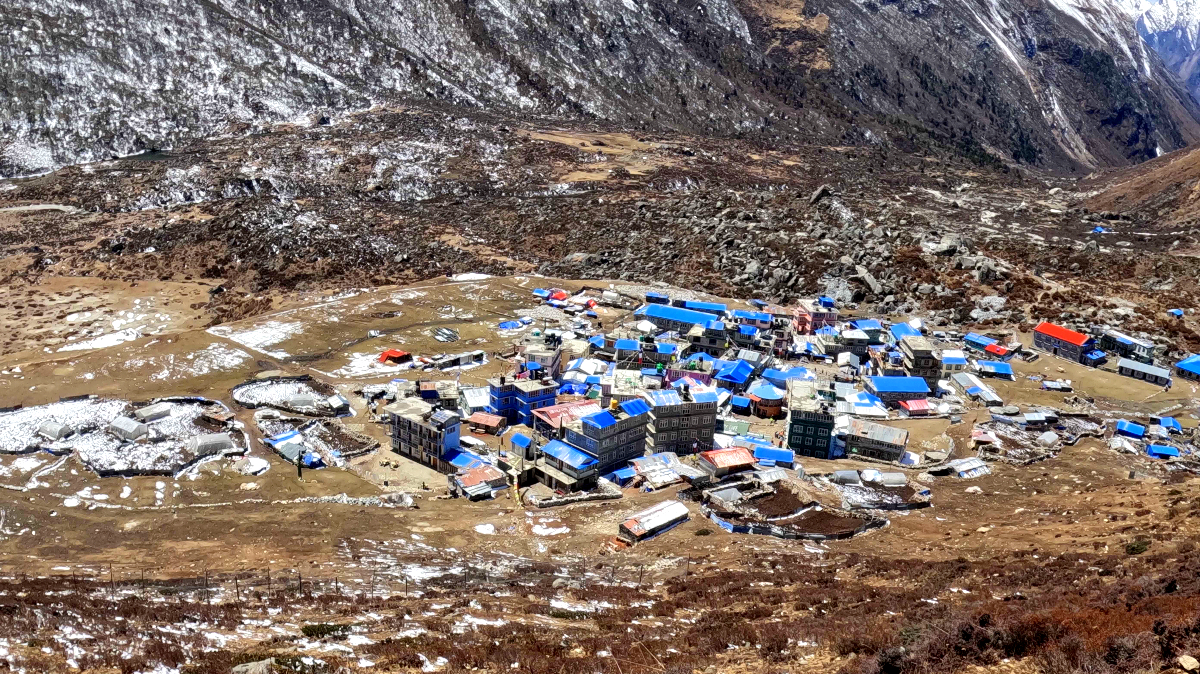
Key Features of Kyanjin Gompa:
-
Spiritual Heart of Langtang: The monastery itself is an active place of worship and meditation, reflecting the strong Tibetan Buddhist influence in the area. Visitors can observe and sometimes participate in the daily rituals and practices that define life in Kyanjin Gompa.
-
Stunning Mountain Scenery: The area offers unparalleled views of the Himalayas, with easy access to viewpoints for Langtang Lirung, the highest peak in the region, and other significant mountains. The natural beauty here is both stark and sublime, with glacial rivers, rugged cliffs, and vast snowfields.
-
Trekking and Exploration: Besides its spiritual significance, Kyanjin Gompa serves as a base for further trekking adventures. Trekkers can venture to the nearby Kyanjin Ri or Tserko Ri for even more dramatic panoramic views of the Himalayas.
-
Local Cheese Factory: An interesting and somewhat unexpected highlight is the local cheese factory, where visitors can learn about the process of making yak cheese, a specialty of the region. This adds a unique cultural and gastronomical aspect to the visit.
-
Flora and Fauna: The surrounding Langtang National Park is rich in biodiversity, offering opportunities to observe a variety of wildlife, including the elusive red panda, and a range of bird species, amidst the rhododendron and bamboo forests.
Kyanjin Gompa is a journey into the heart of the Himalayas, offering a blend of spiritual enrichment, natural beauty, and cultural exploration. Whether you're drawn to the tranquility of Tibetan Buddhism, the challenge of high-altitude treks, or simply the allure of the mountains, Kyanjin Gompa is a place that resonates with the soul of every traveler.
Nagarkot Village
Nagarkot, nestled on the eastern edge of the Kathmandu Valley, is famed for its sunrise and sunset views of the Himalayas, including Mount Everest to the northeast. This village, situated at an altitude of about 2,175 meters, offers a peaceful escape from the hustle and bustle of city life, providing panoramic vistas of the majestic mountains.

Key Features of Nagarkot:
-
Panoramic Views: Nagarkot is best known for its broad vistas that encompass eight Himalayan ranges of Nepal out of the 13, including Annapurna, Manaslu, Ganesh Himal, Langtang, Jugal, Rolwaling, Mahalangur (which includes Mount Everest), and Numbur.
-
Hiking and Trekking: The area is a popular starting point for numerous hiking and trekking trails that weave through the beautiful countryside, offering more intimate encounters with Nepal's natural beauty and cultural heritage.
-
Accessibility: Located just about 32 kilometers east of Kathmandu, it is easily accessible by road and makes for a perfect short trip or weekend getaway from the capital.
-
Accommodation Options: Nagarkot has a range of accommodations, from luxury hotels to modest guesthouses, many of which are strategically positioned to offer the best views of the Himalayas.
-
Bird Watching and Nature Walks: The surrounding forests and fields are rich in biodiversity, making Nagarkot a great place for bird watching and nature walks.
Visiting Nagarkot provides not just a visual treat but also a moment of serenity, allowing travelers to immerse themselves in the tranquil beauty of the Himalayas. It's a reminder of the grandeur of nature and the perfect spot for anyone looking to experience Nepal's famed mountain landscapes without venturing into the more remote trekking routes.
Dhampus Village
Dhampus Village, nestled within the shadows of the breathtaking Annapurna range, is a picturesque embodiment of tranquil rural life in Nepal. This village, situated at an elevation that offers a splendid vista of the Annapurna massif, Machhapuchhre (Fishtail Mountain), and other Himalayan giants, is a serene escape into nature's lap.
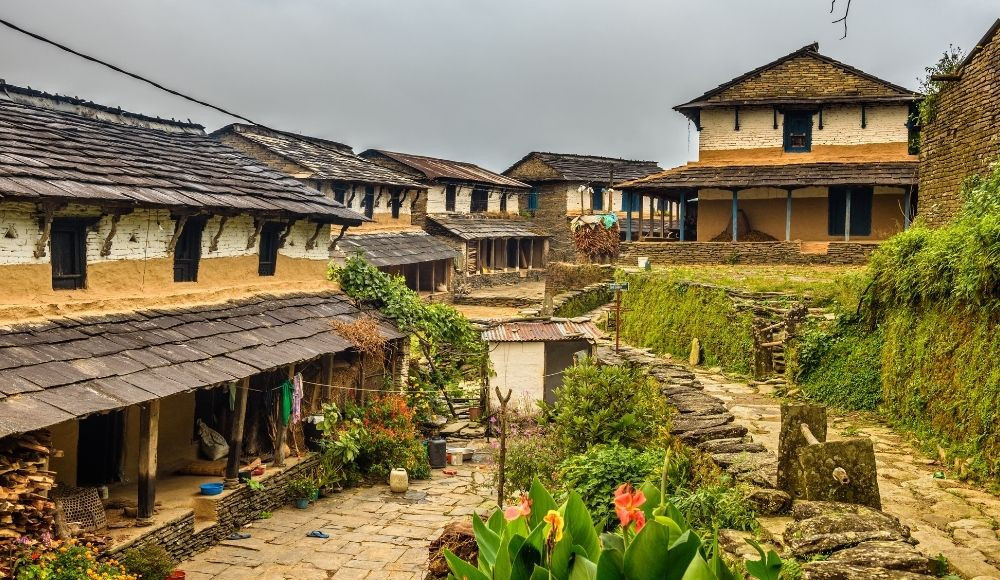
Key Features of Dhampus Village:
-
Gateway to the Annapurna Region: Dhampus serves as an introductory trailhead for several treks within the Annapurna region, making it an ideal starting point for those seeking to explore the majestic Himalayas.
-
Cultural Immersion: The village is predominantly inhabited by the Gurung community, providing visitors with an authentic experience of the local culture, traditions, and lifestyle. The warmth and hospitality of the local people add to the charm of Dhampus.
-
Breathtaking Views: Known for its stunning sunrise and sunset views, Dhampus offers a panoramic spectacle of the Himalayas, providing an awe-inspiring backdrop for trekkers and nature lovers.
-
Eco-tourism: Emphasizing sustainable tourism, Dhampus is an excellent example of eco-tourism practices, with accommodation and dining options designed to minimize environmental impact and support the local economy.
-
Accessibility: Despite its relatively remote location, Dhampus is easily accessible from Pokhara, making it a popular choice for those looking to experience the beauty of the Himalayas without embarking on a strenuous trek.
This village brings visitors closer to the essence of Nepal's rural beauty and the grandeur of the Himalayas. Visiting Dhampus village offers a peaceful retreat, ideal for reflection, rejuvenation, and a deeper connection with nature and culture.
Tips for Top 12 Enchanting Village Tours in Nepal
Embarking on a journey through Nepal's enchanting villages offers a blend of cultural immersion, breathtaking natural beauty, and unforgettable adventures. To make the most of your village tours in Nepal, here are some practical tips:
-
Research and Plan Ahead: Each village offers unique experiences and attractions. Researching their cultural significance, altitude, and accessibility can help you create a more fulfilling itinerary.
-
Acclimatize Properly: Many of these villages are at high altitudes. Take time to acclimatize to prevent altitude sickness, especially when visiting places like Manang or Kyanjin Gompa.
-
Respect Local Customs: Nepalese villages are rich in culture and tradition. Show respect by dressing modestly, asking permission before taking photos, and being mindful of local customs and rituals.
-
Pack Wisely: Weather can be unpredictable. Pack layers for changing temperatures, along with a good pair of walking shoes, sun protection, and any personal medication. Don't forget essentials like a water purification system.
-
Support Local Economy: Opt for homestays, local eateries, and handicrafts made by villagers. This not only enhances your experience but also contributes to the local economy.
-
Learn Basic Nepali Phrases: Communicating in the local language can enrich your interactions. Simple phrases like “Namaste” (Hello) and “Dhanyabaad” (Thank you) can go a long way.
-
Stay Eco-Friendly: Minimize your environmental impact by carrying reusable water bottles, avoiding plastic, and disposing of waste properly.
-
Hire Local Guides: Local guides not only offer valuable insights into the history and culture but also ensure that your visit benefits the community directly.
-
Be Prepared for Basic Facilities: Some villages may have limited amenities. Be prepared for basic accommodation and dining options, especially in more remote areas.
-
Capture Memories, Leave Only Footprints: While it’s important to capture the beauty of these places, ensure you respect the environment and local homes by not intruding on private property or leaving litter.
-
Stay Safe: Always inform someone of your travel plans, especially if trekking between villages, and check local travel advisories.
-
Embrace the Unexpected: Part of the charm of Nepal’s villages lies in their unpredictability. Be open to new experiences, whether it’s trying local food, participating in a festival, or simply enjoying the slower pace of life.
By following these tips, your journey through Nepal’s enchanting villages is sure to be an enriching and memorable adventure, offering a deep dive into the heart and soul of Nepali life.
Exploring the top 12 enchanting village tours in Nepal offers more than just a glimpse into the country's diverse landscapes and cultural tapestry; it's a journey into the heart of what makes Nepal truly unique. From the breathtaking panoramas of the Himalayas in Manang and Kyanjin Gompa to the cultural richness of Bandipur and the historical depth of Chhusang, each village presents its own story, inviting travelers to immerse themselves in experiences that resonate deeply with the soul of Nepal. Embracing these destinations not only enriches your understanding of the world but also supports the preservation of these communities and their way of life. As you return from the serenity of Nepal's villages, you carry with you not just memories of the vistas and faces but a profound connection to the spirit and resilience of the Nepalese people, a reminder of the beauty that thrives in simplicity and harmony with nature.
FAQs of the Top 12 Enchanting Village Tours in Nepal
Q: What is the best time of year to visit these villages in Nepal?
A: The optimal periods for visiting are during spring (March to May) and autumn (September to November). These seasons offer clear skies for mountain views and moderate temperatures ideal for trekking.
Q: Do I need any permits to visit these villages?
A: Yes, permits such as the Annapurna Conservation Area Permit (ACAP) and the Trekkers’ Information Management System (TIMS) card are needed for certain areas. Restricted areas like the Upper Mustang also require additional permits.
Q: How should I prepare for high-altitude village tours?
A: Preparation should include getting physically fit, packing suitable clothing and gear, and familiarizing yourself with altitude sickness symptoms. Including acclimatization days in your itinerary is crucial.
Q: Can I undertake these tours independently, or do I need a guide?
A: While some tours can be done independently, a guide can greatly enhance your experience by providing cultural insights and ensuring safety. For restricted areas, a guide is often mandatory.
Q: What cultural etiquette should I be aware of when visiting these villages?
A: Dress modestly, remove shoes before entering homes or temples, ask permission before taking photos, greet with "Namaste," and express gratitude for hospitality to respect local customs.
Q: Are there accommodation options in these villages?
A: Yes, accommodations range from homestays and teahouses to guesthouses, varying from basic to more comfortable options. Choosing local accommodations supports the community.
Q: What should I pack for a village tour in Nepal?
A: Essential items include layered clothing, a quality sleeping bag, hiking boots, a first-aid kit, water purification methods, sunscreen, a hat, a camera, and extra batteries or a power bank.
Q: Is it safe to trek between these villages?
A: With proper preparation, awareness of weather conditions, understanding your physical limits, and possibly hiring a guide or porter, trekking can be safe. Always let someone know your trekking plans and carry communication means.
If you need any further information, please contact us by email: at [email protected], Phone: at +977- 985 100 5129 (WhatsApp)




